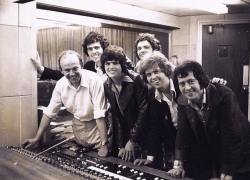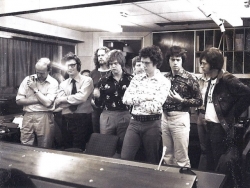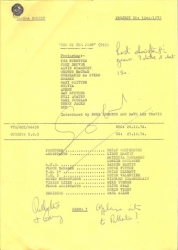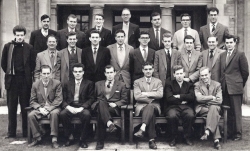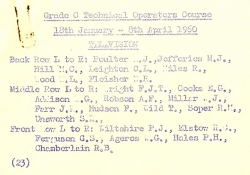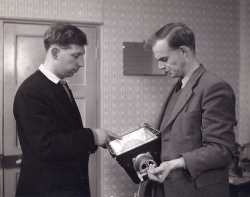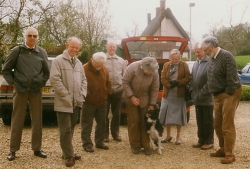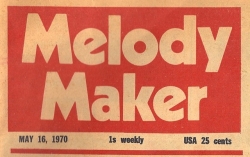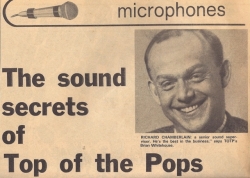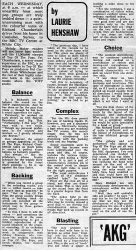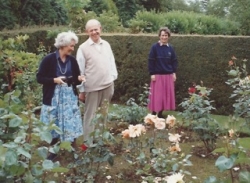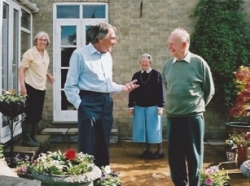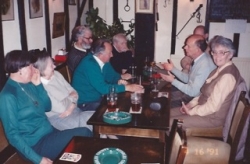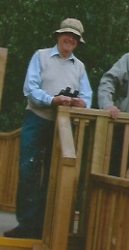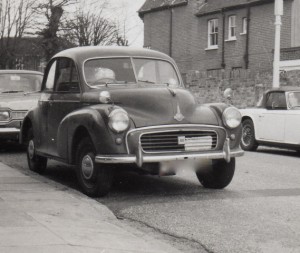In late 2011 John Henshall mentioned a tape he had stashed away to the producers of Tales of TV Centre (BBC 2012) – and caused a sensation. The story is told here on BBC News and you can see the actual recording here . John wanted to give credit to one of the unsung heroes of the BBC, Richard Chamberlain, who was the sound supervisor on the piece, and on most editions of Top of the Pops for many years. The mention of Richard’s name brought forth a pile of memories, and some pictures –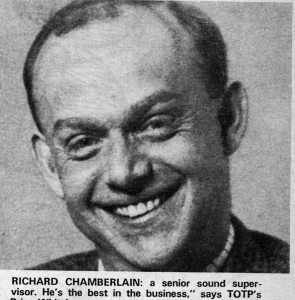
Tony Crake
When I was on Crew 3 doing TOTP ( at L.G ), Wednesday night was ‘sound pre record night’. After a particularly successful recording of “Delilah” we all trooped upstairs to the SCR of “G” to listen to the replay together with a fair array of top brass from EMI + Tom Jones management etc.
I squeezed in behind the equipment racks (some may recall the cramped dimensions of that control room)
As the replay ended the there was what can only be called ‘a stunned silence’. The EMI big cheese looked round at the strange old sound desk ( an EMI creation ! ) plus all Dickie’ s wonderful “add on trolleys”.
“How come Dickie can make it sound like that?” he demanded… there was a bit of mumbling and shuffling about in the background…
“Dickie I want you to come and work for us at EMI now.. £4000 a year plus any expenses (1968) ….. what about it !? ”
Another somewhat pregnant pause, and then… very politely Dickie did that little self depreciating laugh and regretted that he was really quite happy were he was, “but thank you very much anyway! ”
It was a great moment to savour tucked in behind the old grey equipment racks……..
What was £4000 then, equivalent to today I wonder…?
(£57, 240 – I’m sure he’d make more out in the world of today. B)
Dick Blencowe
I too remember working on TOTP with him in Studio G Lime Grove. The band was situated in the studio just below the gallery window and Dickie always used BK6b mics on the violins. These were smallish moving coil mics worn on a string round the neck of each violinist. They were actually intended for the spoken word and usually used for interviews, news readers etc. but they gave the Dickie violin sound that he was famous for.
At his retirement he was presented with a memento of a bronze TOTP logo on a stand with a BK6 hanging on its string round it.
As far as I remember the EMI sound desk was only a feature of the Lime Grove studios and was not regarded highly, but it was more reliable than the PYE desks in the TV Theatre and TC1. Neither were very flexible or had the facilities that we expect from a sound desk today, but at least they didn’t have the rotary faders of their predecessors (BBC Type A?).
Peter Neill
Back in the ’80s (when the IRA were doing naughty things about town) we were in TC8 Sound Gallery during line-up – half an hour before live transmission of TOTP. A besuited gentleman entered the room and informed us that there had been a bomb threat. Although the police were taking it seriously, they believed that it was a hoax and the plan was to go ahead as normal. Dickie’s reaction? He leant over towards his trusty LIM/2 and said, “I’d better put an extra couple of of stops in the limiter then”.
Mike Cotton
Dickie used to have an elderly Morris Minor (?) fitted with a supercharger much to the amazement of boy racers at traffic lights and on some occasions late at night, the police. However he did have to rebuild the engine every 3 months.
He always used to say he came in early to beat the traffic crossing London. On series with a band he would provide a plan and the plugging list for the microphones so that he could spent the time plugging up the sound desk at his leisure to his proven desk layout.
He had a lucky escape in R2 when some of the scene crew moving a flat caught the back end of a Mole boom and the front end came round at great speed and hit Dickie on the side of his head, which he shook and carried on talking. Good job there wasn’t a 4033 in it.
A great man.
Dave Mundy
Apart from his supercharged Morris Minor (in which he used to climb Reigate Hill in top gear!) Dickie also had a Bond 875, a fibre-glass three-wheeler fitted with a Hillman Imp engine. One day he was wizzing down the A316 when he was pulled over by a policeman.
Ever the gentleman, Dickie wound down his window and said ‘Guilty officer, without a doubt’. The policeman answered ‘If I were you sir, I wouldn’t do that sort of speed in this plastic rocket!’ and let Dickie drive slowly away. Then there was his VW beetle in which he took a humpback bridge too fast, landed on it’s nose and shortened it considerably!
More stories after the pictures…..
Pictures from John Howell, Dave Mundy, John Eadon-Eden and Mike Cotton. A special ‘thank you’ to David Chamberlain for supplying Dave with so much memorabilia. David followed his Dad footsteps in BBC sound but due to BBC policy he wasn’t allowed to work at TC and was moved to Birmingham. It wasn’t long before he went freelance and is still working – he has done Wimbledon for many years
Peter Hales
He and I were on the same STO Course (see photographs). In those days I had a 1936 Austin 7 four(?) seater saloon, I don’t think he had a car then. We used to leave Wood Norton on a Friday afternoon and I used to drop him off at Clapham Common Underground Station. I would pick him up at about 9 o’clock on the Sunday evening for the return journey, getting back to Wood Norton sometime after midnight.
We were divided into groups of four for Lab work. We were Dicky, George Ageros, Peter Valentine and myself and it was only on one of these group sessions that I ever saw Dicky lose his cool – with one of the other members.
Dicky was always a cheerful chap with a great sense of humour, he had to be to put up with that journey every weekend!!!
Trevor Webster
As a young chap I had the privilege of being on a tech ops crew that had the great Hugh Barker as Sound Supervisor and the wonderful gentleman Dickie Chamberlain as his ‘assistant’. Dickie got to mix lots of shows which he did with great skill. I think they were just waiting for an opportunity to make him up to Sound Supervisor. The same thing was true of Len Shorey and perhaps some others.
Somewhat later, when Dickie actually had the grade, we heard that he was to mix a live pop show based on chart records – and with no backing tracks! Most of us thought that this wasn’t really possible. For a long time the record companies had been doing a lot of post-production on their singles allegedly making them better and certainly making them distinctive. If the record companies took days or even weeks to get that sound, how could Richard do it live in a television studio? We really thought that poor Dickie was on a hiding to nothing and I should think every sound man in tech ops was glued to BBC1 on the night of the first show.
To our surprise it was remarkably good and as John Holmes put it later, the next week was even better and the third week better still and so on. Week by week Dickie refined his technique and tried new ideas or small variations. His secret was coming in very early (ostensibly to beat the rush hour) but Dickie later told me that, at the end of show one, he wrote down all the final desk settings in an exercise book, so preserving all the little changes he had made in the heat of the battle.
The second week he came in early and used those ‘final’ settings from the start. The exercise book stayed with him for a long time and I believe that it was updated every week in some small way.
However, this is just the recipe of a well organised man. It doesn’t make you the chef! For that you need the real Dickie!
This is the Morris Minor. I bought it from Dickie in about 1971.
For some reason it had a buttock-shaped dent in the roof above the front windscreen. I have fond memories of driving up the motorway with a Fairy-Liquid bottle held out of the driver’s window acting as a windscreen-washer, and of the clutch that kept slipping. The photographs were taken outside my flat in Ealing.
I must admit that working with Dickie was a delight, he was ‘Dickie’. I remember the very early starts, in particular on (I think I remember correctly) a “Peter Sarstedt” in TC7. The RCA BK6B Violin microphones were rather special!

